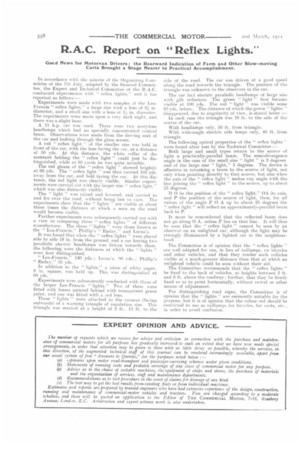R.A.C. Report on "Reflex Lights."
Page 14

If you've noticed an error in this article please click here to report it so we can fix it.
Gocd News for Motorvan Drivers : the Rearward Indication of Farm and Other Slow-moving Carts Brought a Stage Nearer to Practical Accomplishment.
In accordance with the minute of the Organizing Com
mittee of the 7th July, adopted by the General Commit tee, the Expert and Technical Committee of the H.A.C. conducted experiments with " reflex lights," and it has reported as follows:— Experiments were made with two samples at the LeaFrancis " reflex lights," a large size with a lens of 21in. diameter, and a small size with a lens of l4 in. diameter. The experiments were made upon a very dark night, and there was a slight haze.
A 15 h.p. tar was used. There were two acetylene headlamps which had no specially concentrated central beam. Observations were made from the driving seat of the car and looking through the glass screen. A rod " reflex light " of the smaller size was held in front of the car, with the lens facing the car, at a distance of 50 yds. At this distance, the white collar of the assistant holding the "reflex light" could just be distinguished, while at 60 yards he was quite invisible. The red gleam of the " reflex light " showed brightly. at 60 yds. The " reflex light " was then carried 160 yds. away from the car, and held facing the ear. At this distance, the red light was clearly visible. Similar experiments were carried out with the larger size " reflex light," which was also distinctly visible. The " light " was raised and lowered, and carried to and fro over the road, without being lost to view. The experiments show that the "lights ' are visible at about three times the distance at which a man on the road would become visible.
Further experiments were subsequently carried out with a view to comparing three " reflex lights " of different manufacture. The three " lights " were those known as the "Lea-Francis." Phillip's ' Delay," and Lucas's. It was found that when the " reflex lights " were placed side by side 18 in. from the ground, and a car having two parabolic electric headlamps was driven towards them. the following were the distances at which the " lights" were first distinguished. " Len-Francis,' 130 yds. ; Lucas's. 90 yds.: Phillip's " Endav." 50 yds. In addition to the "lights." a piece of white paper. 3 in. square, was held up. This was distinguished at 60 Yds.
Experiments were subsequently conducted with three of the larger Lea-Francis " lights." Two of these were fitted with lenses painted behind with transparent green paint, and one was fitted with a red lens.
These " lights " were attached to the corners (facing outwards) of a warning triangle of regulation size. This triangle was erected at a heieht of 9 ft.. LI ft. to the
side of the road. The car was driven at a good speed along the road towards the triangle. The position of the triangle was unknown to the observers in the car. The car had electric parabolic headlamps of large size with gilt reflectors. The green " light " first became visible at 100 yds. The red " light" was visible some 60 yds, before. The distance at which the green " lights " disappeared, due to angularity of view, is stated below :— Iu each case the triangle was 18 ft. to the side of the centre of the car.
With headlamps only, 50 ft. from triangle. With wide-angle electric side lamps only, 40 ft. from triangle.
The following optical properties of the " reflex lights were found after test by the Technical Committee:—
Both large and small types return to the source of light a practically-parallel beam. The semi-divergence angle in the case of the small size "light " is 3 degrees, and of the large size "light," 5 degrees. The device is effective in returning a beam to the source of light, not only when pointing directly to that source, but also when the axis of the "reflex light" makes any angle with the Line joining the " reflex light " to the source, up to about 25 degrees. If 0 be the position of the "reflex light," OA its axis, and P the position of the source of light, then, for all values of the angle P 0 A up to about 25 degrees the " reflex light " will reflect an approximately-parallel beam back to P.
It must be remembered that the reflected beam does not go along 0 A, unless P lies on that line. It will thus he seen that the " reflex light " cannot be seen by an observer on an unlighted car, although the light may be strongly illuminated by a lighted car in the neighbourhood.
The Committee is of opinion that the " reflex lights " are well adapted for use, in lieu of taillamps. en bicycles and other vehicles, and that they render such vehicles visible at a much-greater distance than that at which an unlighted vehicle could be seen without their aid. The Committee recommends that the " reflex lights " he fixed to the back of vehicles, at heights between 2 ft.
and 6 ft. above the roadway: further, that they be firmly fixed so as to point horizontally, without swivel or other means of adjustment.
For distinguishing road signs, the Committee is of opinion that the "lights " are eminently suitable for the
purpose, but it is of opinion that the colour red should be restricted to use as taillamps for bicycles, far carts, etc., in order to a void con fusion.


























